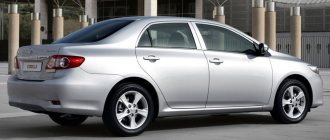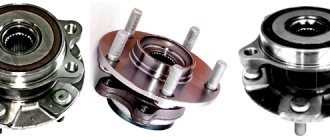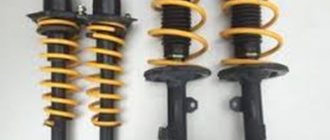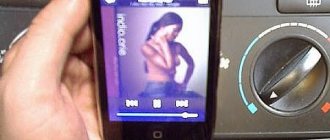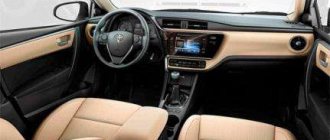The Toyota Corolla suspension is adapted for Russian conditions and withstands harsh operating conditions. When components wear out, extraneous sounds appear or controllability deteriorates. The owner can find and correct defects on his own or transfer the car to a specialized service center.
The Toyota Corolla suspension can withstand difficult operating conditions.
Purpose and functions of suspension in Toyota Corolla
The chassis elements ensure that the wheels are fixed in the required position and support the movement of the hub in the vertical direction. The presence of a steering knuckle allows you to change the direction of movement; inside the unit there is a hole for installing the drive shaft.
The hubs are equipped with brake mechanisms with calipers, connected to the lines by elastic hoses. The suspension allows you to move at high speeds on uneven roads, and the shock absorption system dampens vibrations and shocks that occur while driving.
Diagnostics of Toyota chassis in Moscow
Diagnostics of the chassis of a Toyota car reliably indicates the causes of certain malfunctions. It is carried out both for preventive purposes and in the event of the presence of extraneous sounds from the chassis and other signs indicating the presence of problems. The service is available to clients of our network of car service centers "Tokyo Service".
Having arrived at any of the workshops, owners of used foreign cars:
- undergo free diagnostics;
- spend up to 40% less money than using the service of an official dealer;
- Retains factory warranty.
To check the condition of the chassis, sign up for any of the network services through the form on the website or by phone.
Design features
Corolla passenger cars are equipped with a standard suspension for category C vehicles. Shock absorbers and rubber joints are not very rigid and are not designed for sudden maneuvers. The front wheels need periodic adjustment of the toe angle (the camber is rigidly set by struts and levers). On vehicles with a rear beam, no adjustment is required to the angle, which is inherent in the design.
On machines with a lever arrangement, toe adjustment is provided; the camber is set by suspension elements.
Front suspension
The front-wheel drive Corolla uses a wishbone/MacPherson strut suspension with an anti-roll bar. To dampen vibrations, a shock absorber and a spring with nonlinear stiffness are used. The rack is mounted on the body on a support with a bearing that provides vehicle control. The levers are mounted on a subframe, which increases the rigidity of the suspension.
The front suspension of the Toyota Corolla is supplemented with a stabilizer.
Rear
At the rear, most cars produced use a torsion beam with shock absorbers and coil springs. Starting with the E210 body, the manufacturer used an independent design with a pair of wishbones. The design retains springs, telescopic shock absorbers, and a stabilizer bar has been introduced to improve handling.
The suspension is mounted on a rigid welded subframe, which is bolted to the side members.
How to understand what exactly needs to be repaired?
Having understood the diagram, you can proceed directly to repairing the car. In order to understand what exactly we need to do – i.e. to find out the scope of work, you need to drive the car into a pit and look, assess the level of wear of rubber bands, parts, and so on. In our case, it was noticeable that the car needed to replace the springs and struts - it was clear how the car sank greatly in the rear - the springs and struts of Fielder's Toyota were to blame for this. Therefore, the decision was made to replace these parts. Before starting work, we specially measured the ground clearance near the end of the threshold. In the photo, we can see what he was like. At the end we will show how the car rose, one might say came to life.
Problems that car owners may encounter
Main suspension failures on Toyota Corolla cars:
- P
When driving a Toyota Corolla, knocking noises may appear.the appearance of knocking noises when moving over irregularities that occur when the ball pins of the anti-roll bar struts are destroyed. Repair consists of installing new parts from original production or from alternative suppliers. The average service life of components is 30 thousand km; during maintenance, the rubber bushings of the stabilizer should be inspected and replaced. If there is a hole on the steel rod, you will have to install a new unit.
- Rocking of the car when driving on uneven roads indicates failure of the shock absorbers. Oil stains form on the surface of the housings; repair of parts is not provided. When selecting, you should take into account the year of manufacture of the car and design features.
- Destruction of springs due to fatigue cracks, most often the lower support coil breaks off. The repair consists of disassembling the suspension and installing new parts with suitable rigidity.
- Damage to the boots of ball joints (for example, by sharp branches or ice when driving on dirt roads). Water entering the hinge washes away the lubricant and leads to the formation of corrosion.
- Failure of arm joints due to natural aging of rubber. Some owners experience damage to metal suspension parts due to impacts with rocks or other road obstacles. To restore normal operation, you will need to install new components.
- Corrosion of the subframe with loss of structural strength; repairing the device by welding is not recommended. The owner will need to purchase a new unit; it is permissible to use a subframe removed from a disassembled car.
- A knocking sound when turning indicates wear on the steering arms or damage to the rack. Replacing the rod does not take much time, but requires subsequent adjustment of the toe angle. If the settings are incorrect, the vehicle's handling deteriorates and uneven tread wear occurs. The steering rack should be serviced under service conditions; if restoring the unit is impossible, then you will need to buy a new mechanism.
What should I do?
The Corolla 150 and 120 are durable and reliable cars, but they do not last forever, so to extend the life of your car, you need to pay attention to it. It is recommended to promptly change consumable parts such as stabilizers: thanks to them, the car holds the road better and maneuvers without skidding. As a rule, they need to be changed at around 80 thousand mileage. You can replace them yourself if you have a car design diagram.
It wouldn't hurt to replace the silent blocks along with the stabilizers. Every 150 thousand km it is recommended to change the ball joints.
Self-repair: nuances
The owner can repair the chassis in a garage. To perform the work, you will need a set of locksmith tools and knowledge of the structure of the car. Before carrying out repairs, diagnostics of components is necessary to identify faulty parts. After completing the work, you may need to adjust the toe angle of the front wheels; for adjustment you will need a light or laser stand. During repairs, you should take into account the tightening torques of threaded connections, on which the safe operation of the Toyota Corolla depends.
Removal and installation
To dismantle parts of the front suspension of a car it is necessary (using the example of Toyota Corolla E150):
- U
The Toyota Corolla suspension is being repaired.park the car on a lift or in a garage with an inspection hole.
- Open the hood and remove the plastic frill of the air channel.
- Use a screwdriver to pry off the covers of the support bearing nuts.
- Loosen the fastening, which will later allow you to disassemble the stand.
- Install wheel chocks under the rear wheels, loosen the fastenings of the front discs.
- Raise the front of the car on jacks, place the body on supports, unloading the front suspension.
- Remove the wheels and then release the speed sensor wire clamp.
- Unscrew the fastener and move the wiring harness aside.
- Remove the flexible brake hose from the bracket located on the strut.
- Unscrew the upper mount of the stabilizer bar, holding the pin from turning.
- Unscrew the nuts securing the steering knuckle to the strut; it is recommended to first clean the threads from dirt and coat them with a friction-reducing fluid.
- Unscrew the mountings of the support bearing housing to the body, and then remove the bolts holding the strut to the steering knuckle.
- Disassemble the strut to allow installation of new springs or rubber mounting pads. At the same time, you can assess the condition of the brake discs and pads, service the calipers or install new shields.
- Reassemble the suspension in reverse order. If the steering ends have not been removed from the car, then adjusting the toe angle of the front wheels is not required.
To replace the lever on a Toyota Corolla E150, simply unscrew the ball joint bolts and then unscrew the rubber-to-metal hinge clamps. To remove the bolt of the left vertical silent block, you will need to unscrew the gearbox mount and raise the power unit on a jack or hydraulic stand. When servicing the right side, you will need to remove the engine mount and the cooling system expansion tank. Installation of the lever is carried out in the reverse order, observing the tightening torques.
The torsion beam of the rear suspension is attached to the body with bolts and hinges, which wear out and require replacement. For maintenance, you will need to jack up the car and completely remove the beam. You can remove the hinges using a homemade hydraulic press; it is impossible to knock the glasses out of the guide socket with a hammer. At the same time, you can inspect the springs and gaskets, and assess the condition of the shock absorbers.
After installing new components, it is necessary to tighten the threaded connections and check the functionality of the Toyota Corolla E150 suspension.
Types of pendants
Suspensions predate the invention of automobiles. The prototype of modern automobile suspensions can be considered the suspension system of carriages - their interior was suspended on leather belts or chains. But this design dampened shocks only at low speeds. In 1804, Obadiah Elliott patented a suspension on arc-shaped longitudinal springs; the springs were made of steel, or, less commonly, of elastic wood. Improved suspensions of this type were widely used in cars from the moment they appeared until the 70s of the last century, and are still found on some models today.
The suspensions that were used in different eras on different types of transport differed from each other in their design features. The guiding elements were longitudinal or transverse springs or levers. The elastic elements were springs, springs, torsion bars, rubber blocks, pneumatic cylinders, and hydropneumatic elements. Over more than 2 centuries, dozens of design variations of this unit have appeared. The most common is the division of suspensions according to the type of connection between wheels located on the same axis. According to this principle they are divided into:
- dependent;
- independent;
- semi-dependent.
The dependent suspension rigidly connects the wheels through a continuous beam, so the left and right wheels are always mutually parallel. The disadvantages of this design appear when traveling on uneven roads: when one wheel hits an obstacle, both bend. The main advantage of dependent suspension is its simplicity of design and low price. Motorists half-jokingly say that independent suspension is more convenient as long as it does not need to be repaired. Nowadays, front dependent suspensions are not used on passenger cars, with the exception of some SUVs, and rear suspensions are installed mainly on budget front-wheel drive cars.
In an independent suspension, the wheels are not rigidly connected and move independently from each other; the right and left wheels have their own vibration damping system. They can be connected by swinging axle shafts, a system of longitudinal, transverse or oblique levers. Models with double wishbones may use additional control arms, called a multi-link design. Due to the complexity of the design, the production and maintenance of a multi-link suspension is more expensive than other types, but it provides the most comfortable control.
For cross-country trips, a simplified type of independent suspension is preferable - McPherson (McPherson, floating spark plug). It is this system that is used as the front suspension of the Toyota Corolla. In MacPherson strut suspension, the shock absorber strut consists of a spring and a telescopic shock absorber. The upper part of the shock absorber is attached to the body by an elastic hinge, which allows it to swing. The principle of operation of a suspension with a shock absorber strut is clearly shown in the video.
A semi-independent suspension is cheaper than an independent one, is easier to maintain and provides a smoother ride and improved handling compared to a dependent one. The rear suspension in front-wheel drive cars is often semi-independent, the most common type being a torsion beam. The beam itself, connecting the wheels, is rigid, but it is attached to the body by means of elastic elements - torsion bars. A torsion bar is a rod that twists when the suspension arm moves. When one of the wheels of the axle hits a small obstacle, its vibrations are not transmitted to the second wheel. But if the irregularities are significant, the range of vibrations of the wheel increases and the presence of a connection between the wheels still makes itself felt.
Actions if there is a knock
If extraneous sounds appear while driving, you should determine the source of the knock. Sometimes noise occurs due to poorly stowed tools in the trunk or rolling cargo. If the source of the knock is not detected, then the functionality of the suspension parts should be checked. Small stones that have fallen on the lever or the metal protection of the engine crankcase can make a knocking sound. Sometimes noise is caused by a poorly secured muffler. It is not recommended to operate the car until the cause of the knocking is identified and subsequent repairs are made.
Front and rear suspension maintenance
Checking the condition of the suspension elements of the Toyota Corolla E120 or E150 is carried out in a garage with an inspection pit or on a lift with suspended wheels. Do not operate a vehicle with damaged rubber joints on the levers. You should pay attention to the presence of mechanical defects obtained while driving on the road. Then you need to open the hood and remove the plug to check the tightness of the front strut nut. At the same time, you should make sure that the support bearing housing is securely fastened to the body.
Next, you need to check the tightness of the bolts securing the ball joint to the lever (on both sides), and make sure there are no tears on the rubber cuffs. To check the play, insert a mounting blade between the fist and the lever and rock the tool. Then it is necessary to test the condition of the hinges on the subframe and the reliability of the assembly to the side members. You should also check the serviceability of the stabilizer struts, the integrity of the springs, and make sure that there are no leaks from the shock absorber housings.
About Corolla suspension maintenance
The chassis of a Japanese car is quite simple to maintain. All auto stores have the necessary spare parts, which are inexpensive and easy to change. If you wish, you can replace the springs or stabilizers yourself - this is even easier than changing silent blocks. You can also replace the ball joints or tie rods if they also begin to knock over time. Thus, when buying a Japanese Toyota Corolla, you can be sure of the reliability and ease of maintenance of this vehicle.


